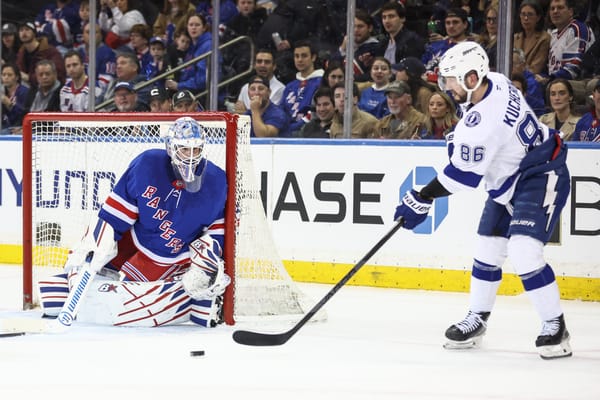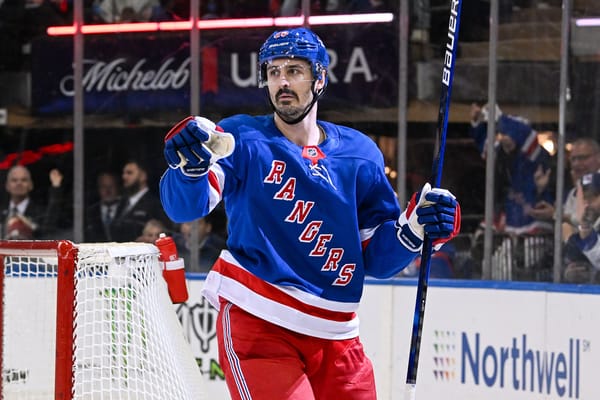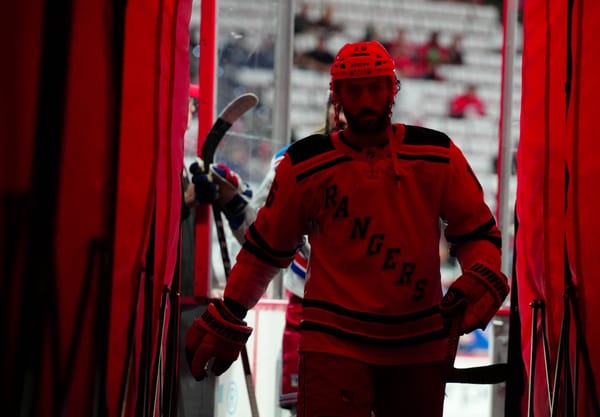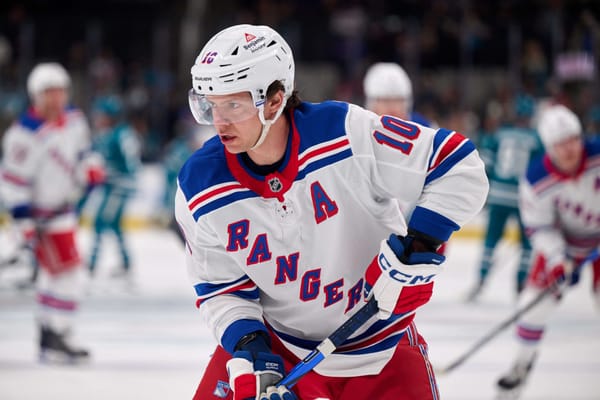Potential Cost-Effective Additions for Improving the Rangers’ Bottom-Six
If the Rangers are going to be better in 2020-2021 than they were this season, it will require some changes to its group of depth forwards without breaking the bank.
The Rangers’ 2020 offseason was already set to be convoluted under traditional circumstances. Among a myriad of unresolved situations, there’s the three-headed goaltending monster, a list of big decisions to make on impending free agents, and the undetermined fate some notable prospects who may or may not be in training camp vying for roster spots. What the team can afford to do with one player is intrinsically tied to the fates of the others, as the team has to prioritize its needs while facing a cap crunch.
COVID-19 further complicates matters as it brings into question the allocating of draft picks, the salary cap in the absence of much of the league’s revenue, the potential for amnesty buyouts, and the general questions of when the league can actually resume activities. Suffice to say that “impact on hockey roster building” ranks among the least important fallout from this pandemic, but within the frivolous context of professional sports, the current situation is going to alter the offseason outlook.
So there’s a lot of unknown right now. That’s true for President John Davidson and General Manager Jeff Gorton, let alone “outsiders” like us. But regardless of what decisions are made, how much cap space the Rangers (don’t) have to work with, and which players stay and go, there is no doubt that the team needs massive improvements to its group of depth forwards. Cap constraints put management in a tricky situation where they must drastically improve while shopping exclusively from the bargain bin. It’s not too early to do some homework on potential options.
Trevor Lewis
The team’s center depth was a disaster this season, and even if we take for granted the idea that Ryan Strome will be back and productive, the team needs another center or two which it can rely on to eat up minutes, preferably in defensive situations, and do a job that Greg McKegg, Brett Howden, and Lias Andersson collectively failed at in 2019-20.
Lewis was drafted by the Los Angeles Kings in 2006 and has been with them for 14-straight years; a rarity for depth players in the salary cap era. However, the center is a 33-year-old free agent this summer and the Kings are at the beginning of what will be a multi-year rebuild. It’s possible that Lewis wishes to stay loyal to the Kings and they would like to keep him as a veteran presence. It’s at least equally likely, however, that Lewis will move on in search of a new ambition.
Lewis maybe isn’t the player he was in his prime, but he’s still an asset as a fourth-line center. He’s a capable defensive center who puts in strong penalty kill shifts, which is a massive need for the Rangers. He may not produce much offense, but the Rangers have other horses in that regard. And he can add an experienced voice to what will still be a young roster trying to find its way.
Evolving Hockey projects that Lewis will get a one-year, $1 million contract, and anything within striking distance of that range would be more than feasible for the Rangers.
Colin Wilson
The Avalanche center has been a quality middle-six center in the NHL for about a decade and, in normal circumstances, wouldn’t on a list like this. However, Wilson suffered an undisclosed lower-body injury in October that required a “couple surgeries” and kept him out for most of the season. David Quinn was an assistant at Boston University when Wilson played there for two seasons. Is it possible Quinn could make an appeal to Wilson on joining him in New York on a short-term deal to rebuild his value? The Rangers would do quite well to add Wilson, who was a two-way center capable of 30-plus points prior to the injury.
Freddie Gauthier
The 2013 first-round pick did not establish himself as an NHLer until his mid-20s, but he’s built out a niche as a fourth-line center for the Leafs the past two seasons. Like Lewis, you’re not getting much in the way of offensive capability, but he can play defensive minutes and excels in tough defensive zone draw matchups.
The Goat is a restricted free agent this summer and will be due for a raise, even if moderate. Is he the most obvious cap casualty? No, but the Leafs are barely squeaking under the salary cap as is. Jason Spezza would likely sign at the league minimum to stay in Toronto and Adam Brooks is pushing for a promotion in the AHL. Though official offer sheet compensation criteria haven’t been made official yet, the Rangers (or any other team) could probably get away with signing Gauthier in the range of $900K-$1.2 million without losing any draft picks. The Leafs need to save anywhere they can and may therefore feel inclined to let him go at that price. A 25-year-old who could cheaply fill some major team needs for multiple seasons, Gauthier would be at the top of my list for fourth-line center solutions if I’m Davidson or Gorton. If moving a late-round pick is necessary to clinch it for sure, then it may be worth it.
Stefan Noesen
Noesen had a strong 2017-18 (relatively speaking) season with the New Jersey Devils, posting 13 goals and 14 assists in 72 games, then regressed the following season. In 2019-20, Noesen returned to productivity, though in weird circumstances. He started the season in the AHL, was an injury call-up and scored once in six games for the Penguins and then was claimed on waivers by the Sharks, where he produced a respectable six goals and two assists in 34 games for a completely dysfunctional San Jose Sharks team.
Noesen has had trouble sticking in the NHL, but now 27 and with 199 regular season games to his name, he has built up a decent enough sample size to show what he’s capable of. His defensive metrics are fairly strong for a depth right-winger, as his team tends to suppress shot quantities and quality when he’s on the ice. And while he’s not a major offensive driver, he does have enough skill to flirt with double-digit goals when given the opportunity. A guy like Noesen is a decent option as a 12th/13th forward who can hold his own on the fourth line for under a $1-million cap hit.
Leon Bristedt
Bristedt is a winger I’ve had on my radar as far back as his freshman season at Minnesota in 2014-15 when I was tracking then-Rangers prospect Brady Skjei. I thought Bristedt would one day become a marquee college free agent, and he looked to be on that path for a while with sophomore and junior campaigns that combined for 32 goals and 38 assists in 74 games. Then, he crashed in his senior season with just five goals and four assists. He did not earn an NHL contract and instead went home to his native Sweden.
Bristedt regained his form in the Swedish Hockey League for Rogle with two strong seasons, including 14 goals and 22 assists in 40 games in 2019-20, and the underlying metrics are incredibly encouraging as well. He ranked third on Rogle in shot attempts percentage (Corsi) and his on-ice shooting percentage was actually a tick lower than average, meaning he’s not riding a wave of shooting fortune.
Aside from his horrendous senior season, Bristedt drew skepticism from scouts because of his meek size; Rogle lists him generously at 5’8 and 183 pounds.
But size has become less-and-less of a concern in the modern game, and Bristedt is more than worthy of a look. The production speaks for itself. He’s an excellent skater who flies up the wings quickly and draws penalties with his feet. As an extremely loose comparison, there are some stylistic comparisons between him and a player such as Carl Hagelin.
Now 25, Bristedt brings the best of both worlds for undrafted free agents. Playing in the NCAA for four years means there’s little concern about the Swede adapting to North American hockey, while his two years in the SHL means he already understands what it means to be a pro. Bristedt is not someone who could be automatically penciled onto the NHL roster, but he’d be a strong contender to earn a spot in training camp or after a short stint in the AHL.
Dmitrij Jaskin
Jaskin was a very good defensive winger for the St. Louis Blues for about six seasons. He was waived prior to the start of the 2018-2019 season by the Washington Capitals and struggled in his 37 games in DC. He spent this season in the KHL with Dynamo Moscow and absolutely dominated, complementing his defensive prowess with an incredible 63 points in 58 games, ranking him second in the league by that measure.
A player like Jaskin serves as a reminder that who does and does not get depth roster spots in the NHL isn’t a 100-percent rigid meritocracy, but rather the result of a big game of musical chairs. Some players don’t fit certain systems. Some teams want to give younger guys a look. Some locker rooms need a different kind of personality. Jaskin had one poor season and suddenly found himself on the outside looking in. Jaskin could have probably signed in the NHL and fought for a spot, but he decided to return home and earn a healthy paycheck as a top player in the KHL.
Jaskin is set to return to the KHL, but he has a clause in his contract that allows him to sign In the NHL if he so wishes. He’s not a pretty player to watch, but Jaskin is an effective defensive forward with an NHL track record who has regained his confidence.
Phil di Giuseppe
David Quinn’s attempts to build a competent bottom-six were disastrous last season and not necessarily through any fault of his own. He tried many different players and combinations but the talent pool was lacking.
A surprise success, though, was Phil di Giuseppe. He was sent down to Hartford after training camp and stayed the length of the season as others around him earned NHL opportunities before being sent back. He finally got his chance in early February and, though the counting numbers aren’t impressive — just one goal and three assists in 20 games — he played very well and became a lineup regular.
One of the appeals of di Giuseppe is his versatility. He has the skating ability and hockey sense to play a shutdown role on the fourth line, but he also proved that he has enough skill to slot in on the top line with Zibanejad and Buchnevich and aide them by getting in on the forecheck and keeping up with the play. The Rangers need a massive clearing out of the incumbent depth forwards, including the extras, but di Giuseppe is one guy who earned the chance to stay. A restricted free agent, di Giuseppe likely will not cost much more than 2019-20 cap hit of $700K, and while he shouldn’t be guaranteed a roster spot, his effectiveness and versatility in his audition as well as what shoul be a frugal cap hit should be enough to project him on the roster for 2020-21.




